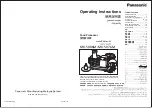
Best Location for OPTIMOD-FM
The best location for OPTIMOD-FM is as close as possible to the transmitter, so that its
stereo encoder output can be connected to the transmitter through a circuit path that
introduces the least possible change in the shape of OPTIMOD-FM’s carefully peak-limited
waveform — a short length of coaxial cable.
If this is impossible, the next best arrangement is to feed the stereo encoder’s baseband
output to the transmitter’s exciter either via a well-conditioned broadband STL radio or
digital link with essentially flat frequency response and constant group delay from 30Hz to
53kHz.
Use the 8200’s left and right analog audio outputs in situations where the stereo encoder and
exciter are under the jurisdiction of an independent transmission authority, and where the
programming agency’s jurisdiction ends at the interface between the audio plant and the link
connecting the audio plant to the transmitter. (The link might be telephone/post lines, analog
microwave radio, or various types of digital paths.) This situation is not ideal because
artifacts that cannot be controlled by the audio processor can be introduced by the link to the
transmitter, by transmitter peak limiters, or by the external stereo encoder.
If the transmitter is not accessible:
All audio processing must be done at the studio, and you must tolerate any damage that
occurs later.
If you can obtain a broadband (0-75kHz) phase-linear link to the transmitter, and the
transmitter authority will accept the delivery of a baseband encoded signal, use the 8200’s
internal stereo encoder at the studio location to feed the STL. Then feed the output of the
STL receiver directly into the transmitter’s exciter with no intervening processing.
If only an audio link is available, use the 8200’s left and right audio outputs and feed the
audio, without pre-emphasis, directly into the link. If possible, request that any transmitter
protection limiters be adjusted for minimum possible action — OPTIMOD-FM does most
of that work. Transmitter protection limiters should respond only to signals caused by faults
or by spurious peaks introduced by imperfections in the link.
To ensure maximum quality, all equipment in the signal path after the studio should be
carefully aligned and qualified to meet the appropriate standards for bandwidth, distortion,
group delay and gain stability, and such equipment should be re-qualified at reasonable
intervals. (See Optimal Control of Peak Modulation Levels on page 1-11).
If the transmitter is accessible:
You can achieve the most accurate control of modulation peaks by locating OPTIMOD-FM
at the transmitter site, and using its stereo encoder to drive the transmitter. You can usually
also obtain good results by locating OPTIMOD-FM at the studio and connecting the
baseband output of its stereo encoder to the transmitter through a composite baseband STL
(see next page). However, many composite baseband STLs do not control peaks perfectly
because of bounce (see next page), and locating OPTIMOD-FM at the transmitter site
(where it can control peaks just prior to the transmitter’s RF exciter) is thus likely to
maximize loudness.
1-12
INTRODUCTION
OPTIMOD-FM 8200











































